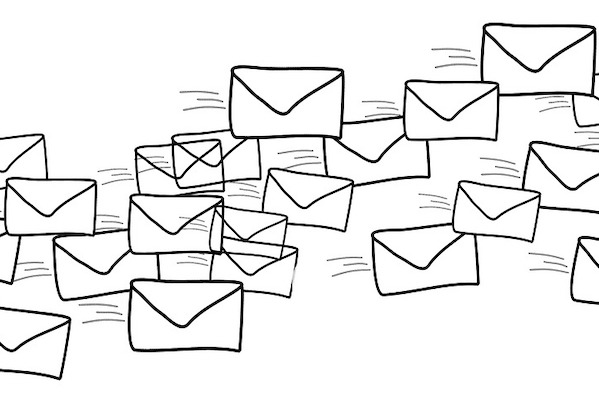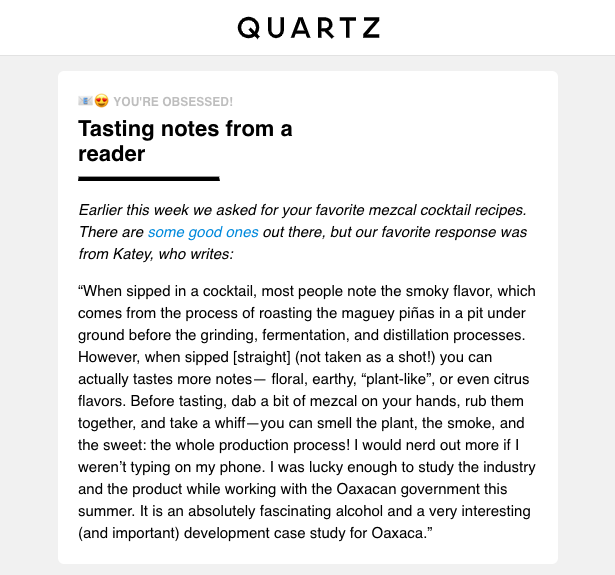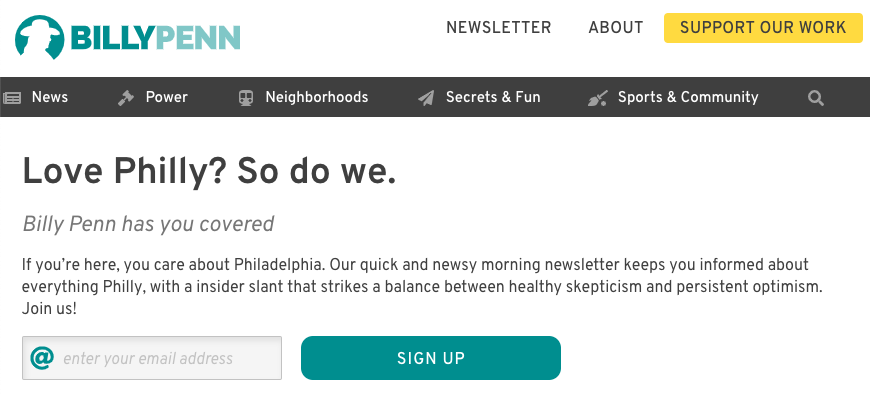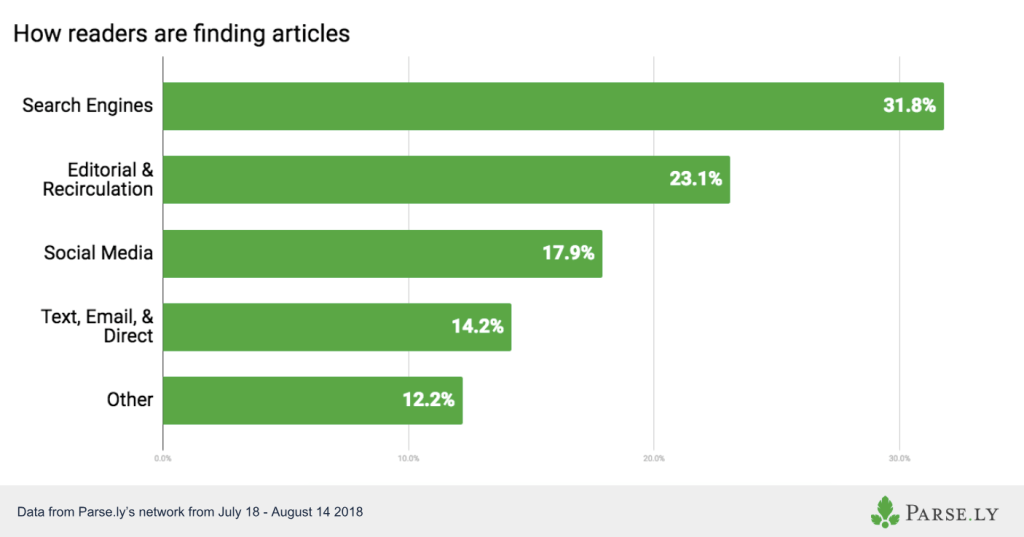3 (more) stats that prove how newsletters create community engagement

Often we think of social media as a form of community. But why not email?
Interactions with newsletters aren’t visible in the form of likes and shares in a news feed, but that doesn’t mean they’re any less an indication of belonging. When a reader interacts with a newsletter, they’re participating in a community of people who value the same information. Unlike social, they’re just doing it in their own personal environment.
The Quartz team enables channels for communication with their email readers, whose responses help shape the newsletter. Weekly active users have grown as a result. “We can see the community forming right before our eyes,” Product Manager Eva Scazzero said of Quartz’s daily Obsession newsletter.
Not only are newsletters a path to engagement, as they are for Quartz, but they can be a path to revenue, as is true for Billy Penn. In case you know someone who still needs convincing that newsletters are valuable, here are three more stats that prove it.
10,000 people wrote in to the Quartz Obsession newsletter in the first year.
The volume of reader responses to the Obsession newsletter, which launched in September 2017, caught the team by surprise. Quickly after launch, they met to develop a solution for categorizing the feedback they received. They made it even easier for people to write in, adding a mail-to link that opens up a pre-composed email.
When experimenting with the product, Scazzero keeps what’s important to readers top-of-mind. For example, she noticed people responded well to call-backs to previous Obsession emails. The team reconsidered how they packaged links to previous newsletter topics so people could make connections between seemingly disparate niche topics and catch up on newsletters that might have gone out before they subscribed.
“We see that readers have needs; we need to translate that into action,” Scazzero said. “Part of my job is making sure that the humanity behind the readers is surfaced and thought about.” Stories and expertise from readers often make their way into the newsletter itself.

By forging a two-way street with their readers, where it was easy for them to express themselves to a team who was really listening, Quartz fostered a community. In the first year of the Obsession newsletter, “10,000 people, individual people, have written to us and engaged with us in a very tangible way,” Scazzero said. “These are not like, hi, you made a typo. These are real conversations.”
People who come from newsletters stay on Billy Penn’s site the longest and return readers are most likely to become paying members.
For Billy Penn, a local independent media organization in Philadelphia, direct reader support is a primary revenue stream. This is one reason why Billy Penn cares deeply about reader feedback. “If we’re going to ask for your support, your financial support, then we’re going to care about what you say,” said Danya Henninger, Editor of Billy Penn.
Feedback arrives most often through direct messages on social media. Readers also email in questions and reply directly to their daily morning newsletter.

Newsletter subscribers are some of their most engaged audience members. “People who come from the newsletter stay on our site the longest,” Henninger observed. The next most engaged readers come through social media. On the other hand, people who visit the site through search spend the least amount of time: “They were looking for an answer, or either they clicked through and didn’t find it, or they don’t know us necessarily.”
Return visitors to the site are more likely to become newsletter subscribers and eventual paying members. “We look at what content gets recurring visitors, what is bringing visitors back again and again,” Henninger said. “Those are the people we want to become our members.”
14% of traffic to content across the web comes from text, email, and direct sources.
Search and social media are often the focus of discussions about referral traffic, especially considering the volume of users and ever-evolving products from platforms like Facebook and Google. For that reason it’s easy to forget that search and social aren’t the whole picture—only half, in fact.
Half of the traffic to Parse.ly’s network of sites comes from sources outside of search and social, which includes homepages, internal recirculation, text messages, email, apps, and RSS feeds. Text, email, and direct sources together send 14% of traffic to the network.

Email, for all its quirks, is an environment that allows editors and marketing teams a certain degree of control. You can curate the content that matters most to you and your readers. You can adjust send time to match your readers’ habits or location. You can segment lists, play with color and design, and A/B test subject lines.
The fact that email is personal, asynchronous, and curated benefits everyone involved: content creators can make 1:1 connections with readers in a channel they own and operate, while readers can experience the content that resonates with them in a personal space.
Metrics that matter for newsletters
How can you tell if your newsletter community is growing and engaged? Here are a few metrics to pay attention to:
- Return visitors: Return visitors is the metric that matters for Billy Penn when connecting direct traffic from email to reader support. The people who visit again and again are likely some of your most loyal readers. For Billy Penn, these returning readers are primed to become newsletter subscribers and eventually paying members.
- Engaged time: When your newsletter refers visitors to your site, how long do they spend with a given piece of content? Is it above average? Are they consistently deeply engaged with specific topics? Newsletter editors who understand what subscribers do after they click within an email can use that information to plan future sends. It can also show how your newsletter readers’ behavior differs from other site visitors’, like it did for Billy Penn.
- Gross open rate: Gross open rate allows Quartz to extract information about forwarding. If someone forwards an email to her friend, the email address of the original recipient gets recorded twice. While there’s no way to prove that action was definitely a forward, a spike in gross open rates can give a sense of which email topics may have inspired people to share.
There are a number of metrics that can indicate breadth and depth. One of the upsides of email is the ability to experiment, both in terms of the formula for measuring success and evolving the content itself. As Eva Scazzero said:
“Email is such an archaic system and it’s very limited. But honestly, when there are limitations, there is so much opportunity for creativity because the constraints are right in front of you. When there are requirements, there is action. We cannot do this. We can do this. Great. Let’s figure it out.”